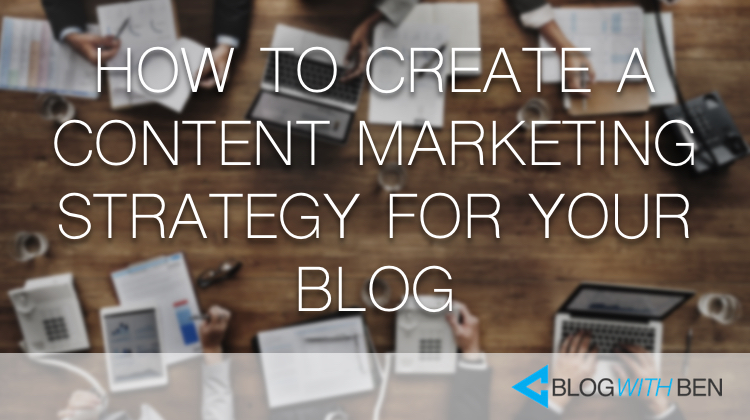How to Create a Content Marketing Strategy for Your Blog
How to Create a Content Marketing Strategy for Your Blog

So, you’ve started a blog and you’ve begun to write a few blog posts. Hopefully, you’re feeling pretty good about yourself…as you should be!
Now that you’ve gotten your feet wet, it’s time to focus on creating a strong content marketing strategy.
In this post, I’ll show you how to formulate a content marketing strategy that will effectively market to your readers, while also helping you become a more focused blogger.
What is Content Marketing?
Before we dive in, I’m assuming that you’re reading this post through the lens of a digital entrepreneur. That’s not to say that content marketing isn’t useful to the everyday blogger, but the strategies in this post are typically used to generate customers. So, now that you’re in the entrepreneurial mindset, let’s take a closer look at what content marketing is.
Simply put, content marketing is a form of marketing that uses content to reach and attract new customers. Instead of pitching your products or services, you’re providing truly relevant and useful content to help your audience solve their problems.
Think of it like this. There are marketing tactics like television ads and cold calls that interrupt everyone's day. On the other hand, content marketing draws people in with useful resources and makes them want to actually visit your blog.
The type of content used in this strategy can vary, but blog posts are one of the most effective methods of content marketing. If you’ve started your blog, you’re already ahead of the game.
Why is Content Marketing Important?
One of the main reasons why content marketing is important is because it can positively impact multiple areas of your blog’s business for a long period of time.
According to an article by Inc., content can theoretically last forever, it never loses value and makes for a perfect long-term investment.
With the right content marketing strategy, you can essentially create useful resources that your audience can access for many years to come. At the same time, you’re setting yourself up for a continuous and positive ROI. It’s the gift that keeps on giving!
How to Create a Content Marketing Strategy?
Now that you have a good feel for what content marketing is and why it’s important, let’s start constructing your blog’s content marketing strategy.
Crafting a successful strategy will take some planning and know-how, but here are some key areas to focus on as you start building out your plan.
Define Your Blog’s Objectives
Before you start creating content, ask yourself, “What’s the objective of my blog?”
Are you selling a product? Are you trying to generate leads? Before you put anything online, it’s important to understand WHY you’re creating content in the first place.
Secondly, your blog’s objectives will ultimately dictate what type of content you create. For example, let's say your blog’s goal is to sell an online course. You’ll want to structure your content marketing strategy so that it's tailored to match your audience’s likes, while also introducing them to the course. Doing so allows you to show them the benefits of the product while leading them through the sales funnel.
Remember, your content marketing strategy is a vehicle for achieving your blog’s business objectives.
Pinpoint Your Target Audience
Once you know your blog’s objectives, it’s time to focus on your audience. One of the best ways to do that is to create a sample persona.
Photo Credit: HubSpot
This popular market research tactic is used by millions of businesses around the world and can help you pinpoint some specific characteristics of your audience. This ultimately allows you to better understand and communicate with the people who are reading your blog.
A sample persona, sometimes referred to as an avatar or buyer persona, is a holistic view of the type of person that’s consuming your content. This isn’t just their age and demographics. A sample personal goes much deeper and helps you truly understand the needs and wants of your audience.
There are a handful of ways to go about gathering this information, but HubSpot offers an awesome (and free) resource that helps you develop a sample persona…if you’re wondering where to start.
Start Conceptualizing Content That Speaks to Your Audience
Next, it’s time to brainstorm on what type of content to create. This too will take some research and know-how, but understanding your audience will play a key role in determining what type of content to use in your marketing strategy.
I know that may sound like a no-brainer, but this is where a lot of bloggers get it wrong. Mainly because they create content that they think their audience wants, or they try to sell directly through their content.
Instead, your content should be a combination of your audience’s interests and your blog’s objectives. It should speak to the reader, while also educating and helping them.
For example, if you’re a yoga instructor, you don’t need to write blog posts about “How to Choose a Yoga Instructor.” Instead, create content like “Top 10 Amazing Health Benefits of Yoga.”
Consider the Sales Funnel
As a digital entrepreneur, your blog will (or should) have a sales funnel. Essentially, your sales funnel is the buying process that your blog leads customers through when they’re making a purchase.
Each sales funnel can differ, depending on your business model, but it’s important to understand the customer journey when you’re creating content.
This allows your content to coincide with each stage of the funnel and ultimately leads your reader towards becoming a repeat customer.
Here’s a quick example of the phases of an effective sales funnel:
- Awareness
- Interest
- Decision
- Action
Knowing where your reader (customer) is at in the sales funnel will help you create content that speaks to their mindset during the customer journey. Remember to always write blog posts that hit each phase of the funnel as well.
Create an Editorial Calendar
Next, it’s time to map out your content with the help of an editorial calendar. This scheduling tool allows you to have a clear roadmap towards achieving your content marketing goals, and it’s a great way to stay on track.
Another great benefit to an editorial calendar is that it conditions you to be organized and consistent. Instead of guessing what you’re going to write about, your editorial calendar plans out your content in advance. You’ll know what to write and when to publish it each and every week.
If you sign up for the Blog With Ben Newsletter, you’ll get instant access to my blogging bundle that includes a free editorial calendar (along with three other downloads). Check it out and get organized!
Promote Your Content
Now that you’ve determined the type of content that speaks to your target audience, it’s time promote the crap out of your content. In other words, it’s time to HUSTLE!
There are multiple ways you can go about promoting your content, and you’ll want to be careful not to overdo it, but no one is going to see your content if you don’t have a solid promotion strategy in place.
To get you started, here’s a quick rundown of how I promote a blog post after it’s published. Feel free to add to this and make it your own, but remember to always have a set promotion strategy when spreading the word about your content.
- Share links to your content across all social media channels the day it’s published.
- Send an email blast to your newsletter notifying them about the new post.
- Tag or email any individuals or businesses that are mentioned within the post.
- Tell your inner circle about the new blog post (word of mouth still works).
- Repeat the process about every other week.
Tools to Help Your Content Marketing Strategy
You have a vast array of resources available that can assist you with your content marketing strategy. However, sometimes it’s easy to get bogged down because there are just so many options. So, here are just a few of my recommended tools to help you craft your future content marketing strategy.
- Blog With Ben Editorial Calendar
- Editorial Calendar WordPress Plugin
- Content Inc. by Joe Pulizzi
- Content Marketing Institute
- Contently Resources
Wrapping Up
If you’re serious about becoming a digital entrepreneur, and you’ve started your blog, then you need to get serious about your content marketing strategy. I know it can seem daunting at first, but once you have a plan in place, I guarantee you that you’ll start to see some positive results from content marketing.

Written by Ben Cummings
Founder of blogwithben.com
Ben is a Digital Marketing and CMS Specialist for Bridgepoint Education who holds an MBA with a specialization in Entrepreneurship. He enjoys teaching, blogging, startups, a hoppy IPA, and college basketball. Whenever he's not blogging, you can find him cruising around sunny San Diego with his amazing family.





Very useful tips! The Editorial Calender is a great idea- I will be recommending it to my sister because Lord knows she needs one haha
That's awesome Timi! Sometimes our siblings need a little extra guidance. When I first started blogging, I didn't really have a content plan or strategy. The editorial calendar is a great way to lift the burden of brainstorming and will make you much more efficient.
Thank Ben am grateful for this little information you given me by next month I will start my blog on sport and betting predictions
You're very welcome, Adejo! Having a content marketing strategy in place before you start your blog can have a positive impact on your blog's launch and long term success. Good luck with your new blog!